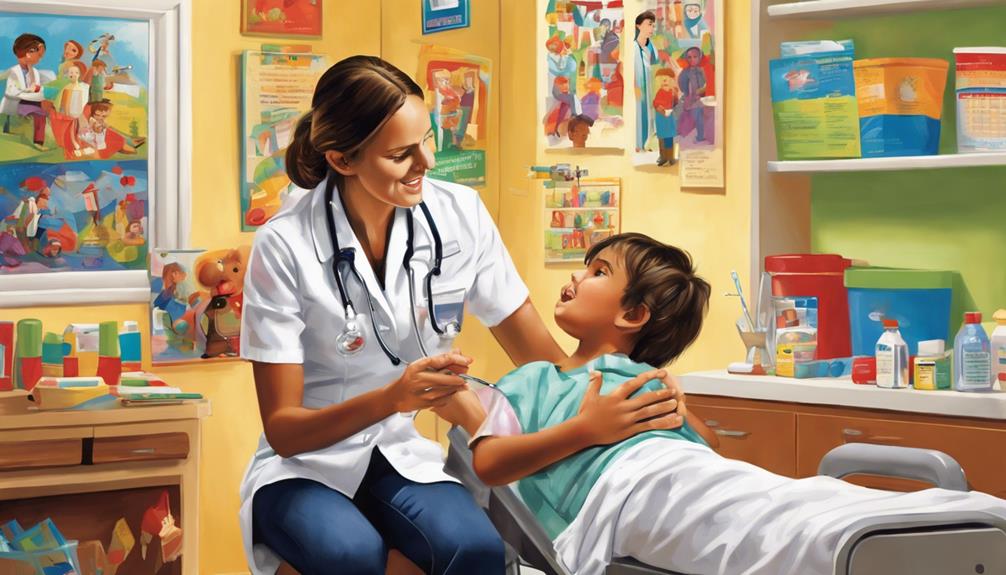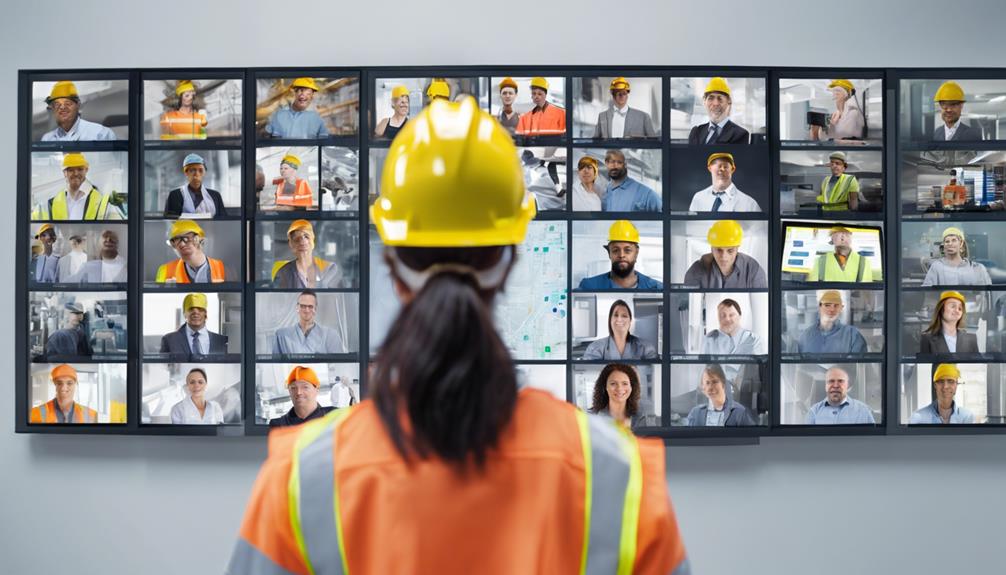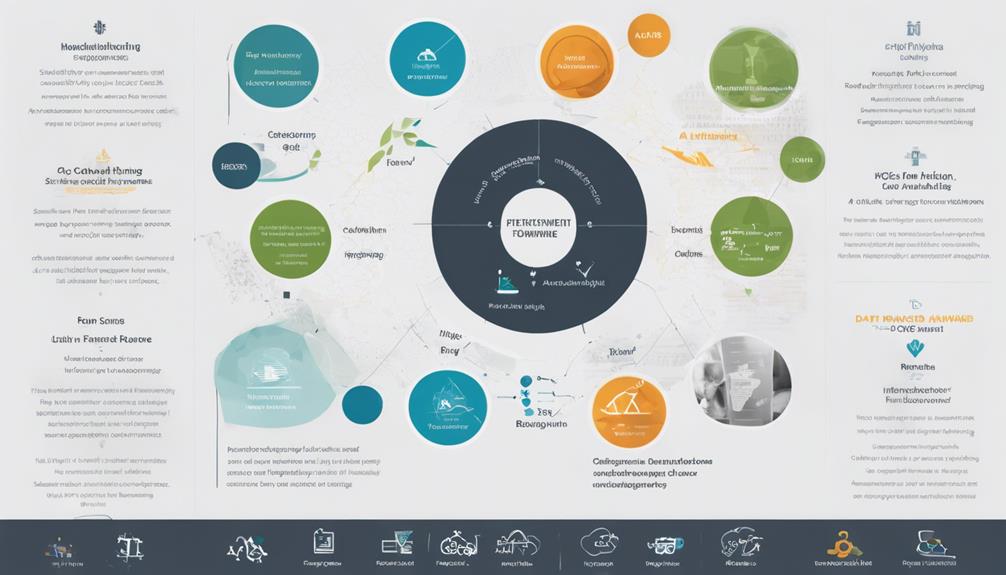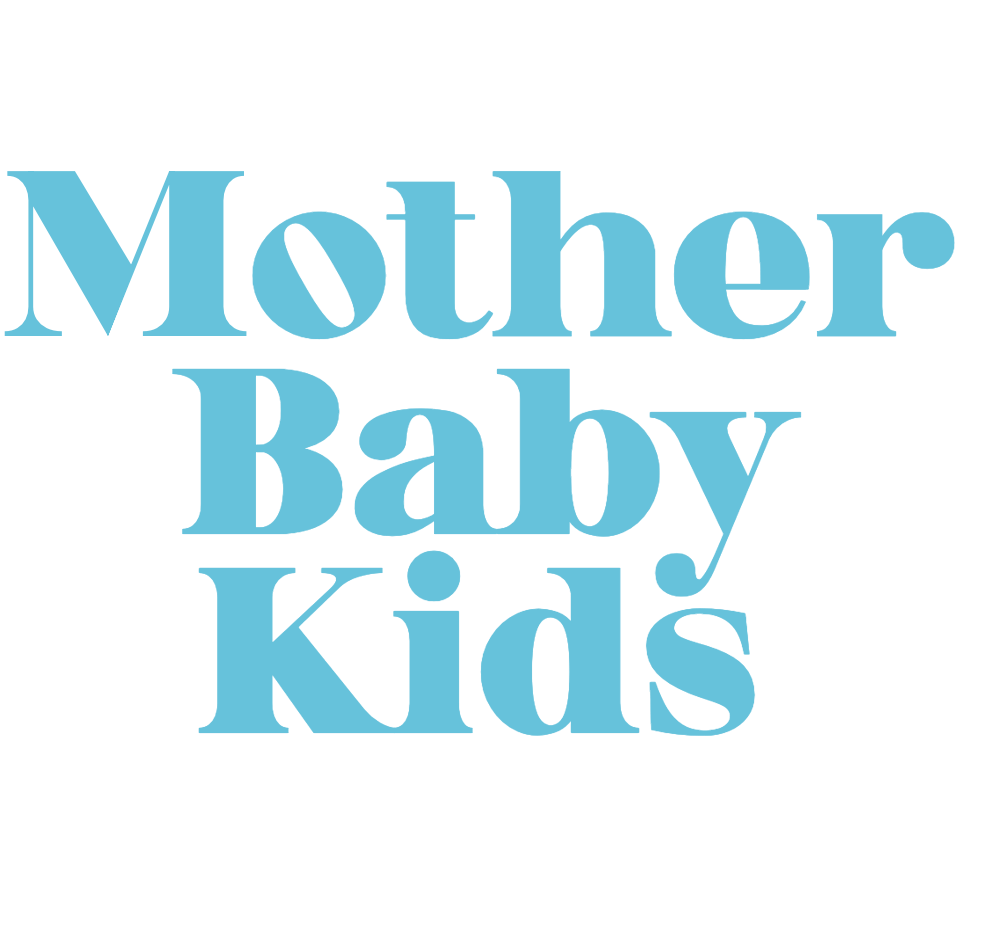Health Checkpoints
What Does Child Health Surveillance in the UK Involve?
Journey through the essential components of Child Health Surveillance in the UK to uncover the meticulous care and monitoring that safeguards children's well-being.

Child Health Surveillance in the UK acts as a careful overseer, continuously monitoring the health of our children. It plays a vital role in protecting their well-being by ensuring vaccinations are up to date and tracking growth and development.
But what specific measures are taken during these surveillance visits? Let's explore the critical approach and essential components that make up this important aspect of pediatric care in the UK.
Key Takeaways
- Regular physical exams and growth tracking are crucial.
- Surveillance includes monitoring developmental milestones.
- Immunizations, health advice, and disease prevention are prioritized.
- Early screening for health issues and promoting overall well-being are key components.
Components of Child Health Surveillance
In monitoring child health, the components of child health surveillance encompass regular physical examinations and measurements to track growth and development. This proactive approach allows us to stay vigilant about a child's well-being, ensuring they're progressing as expected and addressing any concerns promptly.
Through these assessments, we not only monitor physical growth but also keep track of developmental milestones, offering valuable insights into a child's overall health. Additionally, child health surveillance includes updates on immunizations and provides essential preventive health advice to safeguard children from preventable diseases. By offering this extensive support, we aim to promote the holistic well-being of each child under our care.
Moreover, child health surveillance serves as a platform for parents to seek guidance, ask questions, and discuss any worries they may have regarding their child's health and development. Together, we work towards nurturing healthy, thriving children by addressing challenges and celebrating achievements along the way.
Healthy Child Programme Overview

Within the UK's healthcare system, the Healthy Child Programme serves as a thorough framework designed to promote and monitor the health and development of children. This program includes regular health and developmental reviews starting from pregnancy up to 2-2½ years old. By conducting these evaluations, health visitors can identify any issues early on, enabling interventions to support the child's well-being effectively.
The focus lies not only on the child but also on evaluating family strengths, needs, and risks. Through surveillance, the programme aims to prevent diseases and promote healthy growth and development. Screening protocols are in place during antenatal and postnatal care to make certain any health concerns are promptly addressed.
Emphasizing preventive health measures like immunizations, health promotion, and proper nutrition, the Healthy Child Programme plays an important role in safeguarding the health of children and fostering their overall development.
Screening in Child Health Surveillance

During the initial stages of child health surveillance, screening procedures play a critical role in identifying potential health issues early on for timely intervention and support. Screening protocols are designed to guarantee the early detection of health conditions in children, allowing for necessary support and better outcomes. In the UK, newborn screening encompasses physical inspection, hearing tests, blood spot screening, and extensive physical examinations. It is essential to note that screening protocols for antenatal and postnatal care may vary between regions within the UK. By offering all children access to routine immunization schedules, the UK prioritizes preventive health measures as a part of child health surveillance. Through these screening protocols, healthcare professionals aim to identify any health issues promptly, enabling interventions that can lead to improved outcomes and overall well-being for children.
| Aspects of Screening Protocols |
|---|
| Early Detection |
| Health Conditions |
| Necessary Support |
Immunisations and Health Promotion

Our focus lies on guaranteeing children in the UK receive essential immunizations and engage in health promotion activities to safeguard their well-being and prevent childhood illnesses.
All children in the UK are offered access to a routine child immunization schedule, a key component of child health surveillance, aimed at preventing various childhood illnesses.
Health promotion activities target parents responsible for young children, encouraging healthy habits like smoking cessation, minimal alcohol consumption, and drug abstention to ensure overall well-being. Recommendations also include promoting breastfeeding, healthy dietary choices, and dental care practices.
Routine child health surveillance in the UK encompasses providing guidance on nutrition, dental health, and safety measures to promote the child's overall well-being.
Evolution of Preventive Children's Services

Child health surveillance in the UK has undergone a significant transformation, shifting its focus from detection to prevention, with an emphasis on early identification and intervention to promote the well-being of children. This evolution highlights the importance of preventive services in ensuring the best health of our youngest citizens.
Here are three key aspects of this shift:
- Child Health Promotion Programme: In 2004, the term 'Child Health Promotion Programme' replaced Child Health Surveillance, marking a strategic move towards prevention, early detection, and health promotion.
- Role of Paediatricians in Multidisciplinary Teams: Paediatricians play crucial roles within multidisciplinary teams, working collaboratively to promote child health through early identification and support.
- National Service Framework: The National Service Framework underscores the significance of prevention, early detection, and health promotion within child health surveillance and services in the UK. By prioritizing these aspects, the framework aims to enhance the overall well-being of children across the nation.
Frequently Asked Questions
What Is Child Health Surveillance Uk?
Child health surveillance in the UK involves scheduled visits to prevent and detect health conditions in children. We assess physical, emotional, and social development to track progress and identify abnormalities early on for best care.
What Is Health Surveillance Uk?
In health surveillance in the UK, we closely monitor individuals' well-being to detect and prevent health issues. Regular check-ups and data collection aid in maintaining public health. Our aim is to support families and promote overall wellness.
What Does Public Health Surveillance Involve?
Public health surveillance involves monitoring and analyzing health data to identify trends in disease occurrence. It includes tracking communicable and non-communicable diseases, injuries, and environmental hazards. This information guides interventions and public health policies to protect the population.
What Is the Scottish Child Health Surveillance Program?
We guarantee child health through the Scottish Child Health Surveillance Program, offering regular health checks for kids up to age 5. Monitoring growth, development, and well-being helps us detect issues early, providing support for families.
What Role Does Child Health Surveillance Play in the UK and Scotland?
In the UK and Scotland, child health surveillance is crucial for early detection of developmental issues. Despite this, some parents are refusing health visitor Scotland services. This can hinder the monitoring of a child’s health and wellbeing. Encouraging parents to utilize these services is essential for the overall health of children.
Conclusion
In summary, child health surveillance in the UK involves thorough care to guarantee children's well-being.
For example, imagine a young child named Emily who received timely immunizations and developmental screenings during her well-child visits.
Because of this proactive approach, potential health issues were caught early, allowing Emily to thrive and grow into a healthy and happy individual.
This highlights the importance of regular check-ups and preventive care in promoting children's health and development.
With over a decade of experience in editorial leadership, Esther has been at the helm of Mother Baby Kids since its inception. Her journey into parenting content was inspired by her own experiences as a mother, navigating the joys and challenges with a desire to support other parents. Esther is passionate about storytelling that connects, educates, and empowers families from all walks of life.
Health Checkpoints
What Happens at Your Child's 27-Month Check-Up?
Unveil the intricate details of your child's 27-month check-up, delving into their growth, development, and well-being with a comprehensive evaluation.

At your child's 27-month check-up, it's like peering through a window into their world, a snapshot of their growth and well-being frozen in time. From physical measurements to thorough evaluations, this milestone visit offers a detailed assessment of your child's progress and health.
But what about the nuances of their language development or the subtle cues in their social interactions that might be discussed during this appointment? Let's uncover the layers of care and guidance provided to support your child's journey towards a healthy and thriving future.
Key Takeaways
- Developmental milestones in speech, motor skills, and independence are assessed.
- Health screenings cover growth, immunizations, and overall well-being.
- Nutrition and feeding habits are discussed for proper growth and health.
- Sleep patterns and routines are reviewed to ensure restful nights.
Developmental Milestones and Growth
Have your child's growth and developmental milestones been on track at their 27-month check-up? At this age, toddlers typically weigh between 27 to 32 pounds and stand about 34 to 36 inches tall. It's an exciting time as they start forming two-word sentences and expanding their vocabulary to around 50 words. Their motor skills are developing rapidly, allowing them to explore and interact with their surroundings more confidently. Children at 27 months are also showing a growing sense of independence, keen to do things on their own and with a bit of positive reinforcement, they thrive.
Potty training might be on the horizon for some families, bringing both challenges and successes. Offering healthy snacks and making sure they're getting enough vitamin D for their overall development is important. If language delays in toddlers are a concern, discussing this at the child's checkup can provide early intervention support. Celebrate each milestone achieved, big or small, as your child continues to grow and learn at their own pace.
Health Screenings and Vaccinations

During the 27-month check-up, health screenings and vaccinations are necessary to guarantee the child's continued well-being and protection against common childhood illnesses. Our healthcare provider will conduct various screenings to assess your child's growth, development, and overall health status.
Immunizations such as DTaP, IPV, and hepatitis B will be updated to make certain your child remains safeguarded against these preventable diseases. Additionally, vision, hearing, heart, lung, and developmental screenings will be performed to monitor your child's well-being thoroughly.
- Screenings for growth, development, and overall health status
- Updated immunizations for protection against common childhood illnesses
- Vision, hearing, heart, lung, and developmental screenings for thorough health monitoring
This check-up isn't only a chance to make certain your child's physical health but also an opportunity to address any concerns you may have regarding their eating habits, sleeping patterns, behavior, or milestones. Our healthcare provider is here to support you in promoting your child's well-being and to provide guidance on any health-related questions you may have.
Nutrition and Feeding Guidelines

To support your child's healthy growth and development, it's important to follow proper nutrition and feeding guidelines. When it comes to your child's diet, incorporating nutritional guidelines is key. Serve low-fat dairy and limit juice intake to guarantee essential nutrients without excess sugar. Encourage balanced meals with a variety of foods from different food groups to make sure your child receives all the necessary vitamins and minerals. Offering healthy snacks can help maintain energy levels throughout the day while avoiding high sugar, salt, and fat foods can prevent health issues in the future. Establishing regular meal times and family eating routines can create a positive environment around food and encourage healthy eating habits in your child.
| Nutritional Guidelines | Family Eating Routines |
|---|---|
| Serve low-fat dairy | Establish regular meal times |
| Limit juice intake | Encourage family meals together |
| Avoid high sugar, salt, fat | Create a positive food environment |
Sleep Patterns and Recommendations

Establishing a consistent bedtime routine for your toddler at 27 months is important for regulating sleep patterns and promoting restful and quality sleep. Toddlers at this age typically need about 11-12 hours of sleep per night, along with a daytime nap lasting 1-3 hours.
Here are some tips to help you create a soothing bedtime routine:
- Engage in calming activities like reading a book, dimming lights, and playing soothing music to signal the shift to sleep.
- Make sure your child's sleep environment is safe and comfortable, providing a conducive setting for restful sleep.
- Address any sleep-related concerns such as night waking, nightmares, or difficulty falling asleep during the 27-month check-up for guidance and support.
Activities and Behavioral Insights

As we explore the activities and behavioral insights at your child's 27-month check-up, we focus on monitoring progress in speech, hearing, and movement development. During this visit, we pay close attention to your child's social skills, behavior patterns, and interactions with others. We discuss milestones such as vocabulary expansion, promoting independence, and addressing challenges like potty training. Additionally, we provide guidance on dental care, emphasizing the importance of starting good oral hygiene habits early.
Understanding your child's speech and language development through engaging activities and conversations is crucial. Encouraging movement and physical play supports their overall growth and motor skills. By observing behavior patterns, strategies can be offered to support positive interactions with peers and adults. Each child is unique, and tailored advice is here to help your little one thrive.
Frequently Asked Questions
What Happens at 27 Month Check?
At 27 months, we get a thorough check-up. Weight, height, and other aspects are measured. We also have a physical exam to make sure we're growing well. It's a chance for our caregivers to discuss our progress and address any concerns.
Do They Draw Blood at 2 Year Check Up?
No, blood draws aren't usually part of a 2-year check-up, unless there are specific health concerns like anemia or lead exposure. We should always discuss any worries about blood draws with the healthcare provider.
What Happens at a 2 Year Check Up?
At a 2-year check-up, we measure weight, height, and BMI to track growth. A thorough physical exam checks eyes, heart, lungs, and development. Immunizations are updated, and we address milestones, concerns, and offer guidance on nutrition, safety, and well-being.
Do Babies Get Shots at 2 Year Check Up?
Yes, babies typically receive essential immunizations at their 2-year check-up, including catch-up shots. These vaccines protect against serious illnesses like hepatitis B, DTaP, and influenza, ensuring our little ones stay healthy and safe.
Conclusion
As parents, we want the best for our little ones. At the 27-month check-up, it's amazing to see how much our children have grown and developed.
Did you know that by this age, many toddlers have already learned over 200 words? It's truly a joy to witness their language skills blossom and their personalities shine.
Remember, every milestone is a step towards a bright future for our precious children.
With over a decade of experience in editorial leadership, Esther has been at the helm of Mother Baby Kids since its inception. Her journey into parenting content was inspired by her own experiences as a mother, navigating the joys and challenges with a desire to support other parents. Esther is passionate about storytelling that connects, educates, and empowers families from all walks of life.
Health Checkpoints
Why Health Surveillance and Monitoring Are Required for Workplace Safety
Peek into the unseen workplace dangers and discover how health surveillance can safeguard employees – uncover the hidden risks ahead.

In today’s fast-paced work environment, monitoring employee health closely is not only a precautionary measure; it is a necessity.
Health surveillance and monitoring play a critical role in ensuring workplace safety by detecting potential risks early on and taking necessary actions.
But have you ever wondered why these practices are so crucial?
Stay tuned to learn about the unseen dangers that lurk within workplaces and how health surveillance can be the key to addressing them effectively.
Key Takeaways
- Essential for safeguarding employees' well-being and confirming exposure to workplace hazards
- Prevents work-related health risks and enhances employee well-being
- Identifies workplace hazards, tracks exposure, and appraises control measures
- Contributes to workplace safety by monitoring effectiveness, ensuring compliance, and improving safety measures
Importance of Health Surveillance
Health surveillance plays an essential role in proactively safeguarding the well-being of employees by detecting early signs of work-related health changes. Surveillance is critical in confirming exposure to workplace hazards and appraising the effectiveness of control measures.
By monitoring employee health trends, organizations can prevent work-related health risks and implement preventive strategies. Through health surveillance, potential problem areas can be identified, leading to the establishment of necessary control measures.
Regular health surveillance evaluations are essential to evaluate the impact of workplace conditions on employee health and safety, ensuring a proactive approach to addressing any emerging issues promptly. By staying vigilant through surveillance and evaluations, organizations can continuously improve their occupational health and safety standards, fostering a culture of care and well-being for all employees.
Role of Monitoring in Safety

Monitoring in workplace safety is a critical component in tracking exposure to hazards and identifying early signs of occupational illnesses or injuries. By regularly monitoring workplace exposures, organizations can guarantee compliance with safety regulations and take a crucial approach to health management. Monitoring also plays an essential role in evaluating the effectiveness of control measures in preventing work-related health issues. Timely monitoring interventions can lead to improved safety measures and enhance the overall well-being of employees.
| Role of Monitoring in Safety | |
|---|---|
| Key Aspects | Benefits |
| Tracking hazards exposure | Identifying health risks |
| Early detection of illnesses | Guaranteeing regulatory compliance |
| Evaluating control measures | Improving safety measures |
| Proactive health management | Enhancing employee well-being |
Preventing Workplace Hazards

Regularly evaluating and mitigating potential workplace hazards is essential for guaranteeing a safe and thorough work environment. To prevent workplace hazards effectively, organizations should implement the following strategies:
- Establishing a detailed surveillance program: Developing a robust surveillance program enables the continuous monitoring of employees' health status, facilitating the early detection of any work-related health changes.
- Implementing control measures: Identifying potential workplace risks through regular surveillance allows for the timely implementation of control measures to reduce or eliminate hazards before they escalate.
- Leveraging preventive strategies: Monitoring employees' health trends not only helps in the early detection of occupational health issues but also ensures that preventive strategies are tailored to address specific risks, creating a safer work environment for all.
Ensuring Employee Well-being

To guarantee the well-being of employees in the workplace, it's imperative to establish a thorough framework that prioritizes their safety and health through proactive measures.
Health surveillance plays a vital role in ensuring employee well-being by enabling the early detection of work-related health issues. By monitoring trends in employee health, potential workplace hazards can be identified, allowing for preventive action to be taken promptly. Regular surveillance not only aids in detecting occupational health risks early but also reduces the impact on employee well-being.
Additionally, effective health surveillance programs contribute greatly to the prevention of work-related health risks, ultimately promoting a safer work environment for all employees. Prioritizing health surveillance not only safeguards employee well-being but also enhances overall workplace safety by addressing potential health concerns before they escalate.
Contribution to Workplace Safety

Conducting thorough health surveillance and monitoring programs is a fundamental aspect of ensuring workplace safety and regulatory compliance. Through these programs, we can actively contribute to the enhancement of workplace safety by:
- Detecting Early Signs of Work-Related Health Issues: By monitoring employee health regularly, we can catch potential health issues early on, preventing them from escalating into serious conditions.
- Identifying Workplace Hazards and Trends: Surveillance helps in recognizing patterns and trends in workplace hazards, enabling us to intervene promptly and create a safer work environment.
- Monitoring Effectiveness of Control Measures: Utilizing surveillance data allows us to evaluate the efficacy of control measures implemented to reduce occupational health risks, ensuring they're adequately protecting employees.
Frequently Asked Questions
What Is the Purpose of Health Surveillance?
Monitoring health surveillance serves to track early signs of work-related health changes, evaluating exposure effects, confirming hazards, and ensuring effective preventive measures. Identifying potential health issues, evaluating trends, and addressing problems swiftly are crucial.
Why Is a Good Occupational Health Surveillance Program Important?
Monitoring worker health through robust surveillance programs allows us to proactively address workplace hazards, prevent health issues, and assess control measures effectively. These programs track trends, guide interventions, and support evidence-based decision-making for improved safety and health outcomes.
What Is the Purpose of Medical Surveillance?
We monitor workers' health through medical surveillance to detect and address potential risks early. Regular assessments tailored to workplace exposures help us verify safety, evaluate control measures, and protect workers from occupational health hazards efficiently.
What Are the Medical Surveillance Requirements of Osha?
We follow OSHA's medical surveillance requirements, which mandate regular health assessments for employees exposed to workplace hazards. These evaluations help monitor any adverse effects and prevent work-related health issues, ensuring compliance and promoting safety.
Conclusion
To sum up, health surveillance and monitoring play a critical role in maintaining workplace safety. By continuously monitoring employee health and detecting potential risks, we can prevent workplace hazards and safeguard the well-being of our team.
This proactive approach not only keeps employees safe but also contributes to the overall safety culture in the workplace. Let's continue to prioritize health surveillance to create a safer and healthier work environment for everyone.
With over a decade of experience in editorial leadership, Esther has been at the helm of Mother Baby Kids since its inception. Her journey into parenting content was inspired by her own experiences as a mother, navigating the joys and challenges with a desire to support other parents. Esther is passionate about storytelling that connects, educates, and empowers families from all walks of life.
Health Checkpoints
What Does the HCP 2-Year Review Entail?
Step into the intricate tapestry of human capital management strategies with the HCP 2-Year Review, uncovering insights that shape organizational success.

As we step into the domain of the HCP 2-Year Review, imagine peeling back the layers of an organization's human capital landscape to reveal the intricate tapestry woven by its strategies and initiatives.
This evaluation serves as a compass, guiding us through the past two years of workforce dynamics, talent nurturing, and performance trajectories.
But what lies beneath the surface of this review? What insights await us as we dissect the essence of human capital management strategies?
Join us on this journey as we unravel the significance and impact of the HCP 2-Year Review on organizational growth and success.
Key Takeaways
- Thorough evaluation of feedback quality and retention rates over two years
- Analysis of demographic disparities and compliance with legislation
- Actionable feedback for professional growth and goal alignment
- Strategies focus on continuous improvement and fair feedback practices
Overview of HCP 2-Year Review Process
The overview of the HCP 2-Year Review process reveals a structured approach to evaluating feedback quality and addressing retention challenges over two years. This extended timeframe allows for a thorough analysis of trends and patterns in feedback reception and retention rates. By looking at data over this period, the review can identify long-term issues and track the effectiveness of implemented strategies.
During these two years, the review delves deep into differences in feedback quality among different demographic groups. This in-depth analysis enables a nuanced understanding of the challenges faced by each group, leading to tailored solutions that promote inclusivity and fairness in the feedback process. Additionally, the emphasis on actionable feedback throughout the two-year period ensures that growth processes are fair and transparent for all individuals involved.
Legislative support for transparent feedback and promotion practices has been steadily increasing over the two years of the review. This backing provides a solid foundation for the review's recommendations and fosters a culture of openness and accountability within the organization.
Purpose and Objectives of Review

Initiating an evaluation of employee performance and development spanning a two-year period, the HCP 2-Year Review aims to align organizational objectives with employee expectations while fostering professional growth. The objectives of the review encompass appraising progress towards goals, providing constructive feedback, and identifying areas for enhancement. It serves as a pivotal checkpoint to make certain employees are on the right path for advancement and success within the company. By aligning individual aspirations with company goals, this review promotes a symbiotic relationship where both the employee and the organization benefit. Moreover, the HCP 2-Year Review plays an important role in enhancing communication, fostering employee engagement, and retaining top talent within the organization.
| Purpose | Objectives | Outcomes |
|---|---|---|
| Evaluate employee performance and development | Appraise progress towards goals, provide feedback, identify areas for improvement | Alignment of expectations, professional growth |
Key Components Evaluated

In our evaluation, we focus on evaluating the key components such as feedback quality and its impact on retention rates during the HCP 2-Year Review.
- Feedback Quality Assessment: We meticulously examine the quality of feedback provided to healthcare professionals, ensuring it's constructive, specific, and geared towards professional development.
- Retention Rate Analysis: We investigate into the data to understand how feedback quality correlates with employee retention rates, aiming to enhance strategies that foster long-term commitment and loyalty.
- Demographic Disparities Exploration: We scrutinize feedback disparities among different demographic groups, shedding light on any potential biases that may exist and aiming for fairness and equity in the feedback process.
- Legislative Compliance Review: We assess the organization's adherence to legislative frameworks regarding fair feedback practices, ensuring that feedback processes are aligned with legal standards and promote a supportive work environment.
Importance of Actionable Feedback

Moving from the evaluation of key components during the HCP 2-Year Review, we now examine the significance of actionable feedback in driving employee development and organizational growth. Feedback is a powerful tool for improvement, yet 50% of employees have received non-actionable feedback, hindering their progress.
To guarantee feedback drives development, fairness and equity in processes are essential. Organizations are facing pressure to enhance feedback quality, with legislative actions pushing for transparency in feedback practices. Effective management and feedback processes are increasingly recognized as essential for employee growth and retention.
The demand for actionable feedback is so critical that states and cities are considering laws to improve promotion transparency, highlighting the importance of feedback in organizational success. By prioritizing actionable feedback, organizations can create a culture of continuous improvement and support employees in reaching their full potential.
Strategies for Improvement and Growth

To enhance organizational development and foster employee growth effectively, implementing strategic feedback mechanisms is essential. Here are four strategies to explore:
- Regular Feedback Sessions: Conducting regular feedback sessions helps employees understand what's expected of them for promotion and growth within the organization.
- Clear, Actionable Feedback: Providing clear and actionable feedback to all demographic groups can help reduce disparities and improve retention rates among employees.
- Culture of Feedback and Improvement: Developing a culture that values feedback and continuous improvement can lead to increased employee engagement and satisfaction levels.
- Legislative Support for Fair Practices: Legislative support for fair feedback practices emphasizes the importance of transparency in promotion processes, ensuring equality and fairness for all employees.
Frequently Asked Questions
What Should Be Included in a Year Review?
In a year review, we include feedback on performance, goal progress, areas for growth, and development chances. Clear expectations set at the start are essential. Regular check-ins help monitor progress and address issues promptly.
What Happens in an Annual Performance Review?
In an annual performance review, we receive feedback from managers on our work, strengths, areas for growth, and goal progress. Ratings may be given, and discussions on career prospects, promotions, and salary adjustments occur.
What Is the HR Performance Review Process?
We assess employee progress through goal setting, feedback, and evaluation in HR performance reviews. Collaborating with managers, we establish expectations, review achievements, and discuss strengths, areas for improvement, and career growth opportunities.
What Is Discussed in a Performance Review?
In a performance review, we analyze accomplishments, set goals for growth, and discuss feedback to enhance job performance. These reviews align our work with organizational objectives and support our professional development for success.
Conclusion
To sum up, the HCP 2-Year Review provides valuable insights into an organization's human capital management practices.
One interesting statistic to note is that organizations that prioritize employee development see a 22% increase in employee retention rates.
By utilizing feedback from the review to drive improvements in workforce planning, talent acquisition, and performance management, organizations can enhance employee engagement and ultimately achieve greater organizational success.
With over a decade of experience in editorial leadership, Esther has been at the helm of Mother Baby Kids since its inception. Her journey into parenting content was inspired by her own experiences as a mother, navigating the joys and challenges with a desire to support other parents. Esther is passionate about storytelling that connects, educates, and empowers families from all walks of life.
-

 Third Trimester3 weeks ago
Third Trimester3 weeks agoManaging Nausea in the Third Trimester: A How-To Guide
-

 Third Trimester1 week ago
Third Trimester1 week agoManaging Nausea During the Third Trimester: A How-To Guide
-

 Third Trimester2 weeks ago
Third Trimester2 weeks agoSafe Third Trimester Exercise Guide for Moms-to-Be
-

 First Trimester3 months ago
First Trimester3 months agoDramamine Use in Pregnancy: First Trimester Guide
-

 Newborn Care12 hours ago
Newborn Care12 hours agoNewborn Care Basics: A Step-by-Step Guide
-

 Second Trimester3 months ago
Second Trimester3 months ago10 Common Causes of Dizziness in the Second Trimester
-

 Finding Time for Self2 months ago
Finding Time for Self2 months agoSelf-Care Tips for Single Parents | Make Time for You
-

 Finding Time for Self2 months ago
Finding Time for Self2 months agoSelf-Care for Stay-at-Home Moms: Making Time













